(Written by BLProductions)
Over the last ten years or so, LEGO has been producing sets that contain hundreds or even thousands of pieces more – and cost a lot more – than what we can find in their normal product ranges. The company refers to these sets as LEGO Exclusives. This year LEGO released an unusually large number of LEGO Exclusive-size sets, so I thought to take some time and research the largest LEGO sets of all time, compare them, and share the results with you. 🙂
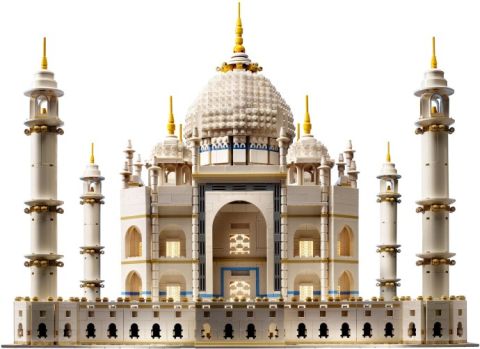
So what exactly qualifies as a LEGO Exclusive set? There are actually a number of potential factors, such as large piece-count, high price, limited production, special licensing, etc. For this article, I chose to focus on the piece-count and the price. Using the extensive database of Brickset.com, I was able to narrow down my search to sets that contain more than 3,000 pieces, or have an original retail price of $300 or more. It turns out that as of now, LEGO produced 15 sets with more than 3,000 pieces. The top ten of these are listed below:
- #10189 LEGO Taj Mahal – 5,922 pieces
- #10179 LEGO Star Wars Millennium Falcon – 5,195 pieces
- #75827 LEGO Ghostbusters Firehouse Headquarters – 4,634 pieces
- #10214 LEGO Creator Tower Bridge – 4,287 pieces
- #10253 LEGO Creator Big Ben – 4,163 pieces
- #71040 LEGO Disney Castle – 4,080 pieces
- #75159 LEGO Star Wars Death Star – 4,016 pieces
- #42055 LEGO Technic Bucket Wheel Excavator – 3,927 pieces
- #10188 LEGO Star Wars Death Star – 3,803 pieces
- #10143 LEGO Star Wars Death Star II – 3,441 pieces
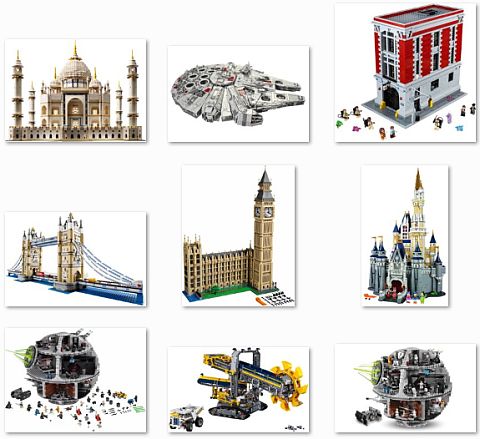
While this list is very straightforward, it does not take into consideration how the sets compare in prices. Looking at the Brickset database again, we find that LEGO released twelve sets with an original retail price of $300 or more. So to get a combined list, I added the positions of each set from both lists together. To complicate things however, some of the $300+ sets did not contain more than 3,000 pieces, and some of the sets I listed above did not retail for over $300 (both of which are due to LEGO’s inconsistent pricing). This of course greatly alters the results. Taking everything into consideration I ended up with the following list of what can be called the eleven largest LEGO sets of all time. The list shows the set’s name and number, the piece count, the original retail price, and the year it was released.
- #10179 LEGO Star Wars Millennium Falcon: $500 – 5,195 pieces – 2007
- #75827 LEGO Ghostbusters Firehouse HQ: $350 – 4,634 pieces – 2016
- #75159 LEGO Star Wars Death Star: $500 – 4,016 pieces – 2016
- #10189 LEGO Taj Mahal: $300 – 5,922 pieces – 2008
- #71040 LEGO Disney Castle: $350 – 4,080 pieces – 2016
- #10188 LEGO Star Wars Death Star: $400 – 3,803 pieces – 2008
- #10221 Star Wars Super Star Destroyer – $400 – 3,152 pieces – 2011
- #10253 LEGO Creator Big Ben: $250 – 4,163 pieces – 2016
- #42055 Technic Bucket Wheel Excavator: $280 – 3,927 pieces – 2016
- #10214 LEGO Creator Tower Bridge: $240 – 4,287 pieces – 2010
- #75059 LEGO Star Wars Sandcrawler: $300 – 3,296 pieces – 2014
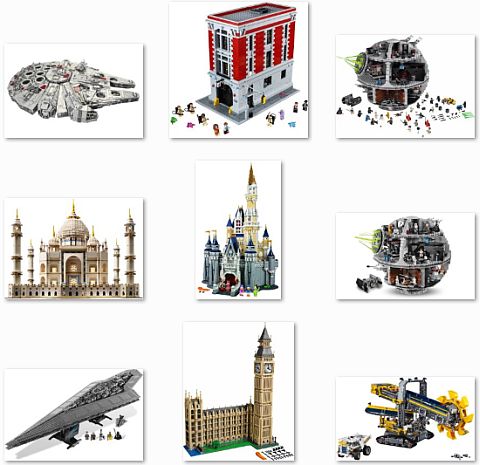
As you can see, the order of the sets in the second list changed greatly from the first. This is mostly because of the extra-high prices of the licensed sets. Looking at the year of release, it is interesting to note that five out of the eleven sets are from this year! Fortunately all five are good sets, and in a wide variety of themes, so there is something for everyone. Our wallets may not be so happy however.
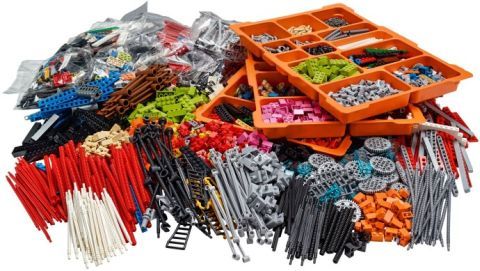
There is one slight issue with my final list however. There are three LEGO sets that should be on the list, but are not. These are the #200430 LEGO Serious Play Identity and Landscape Kit, the #2000431 LEGO Serious Play Connections Kit, and the LEGO Serious Play #2000409 Window Exploration Bag. These three sets retail for $790, $755, and $485 respectively, making the first two the most expensive LEGO products in history. Why are they not on the list? I chose not to include them because they are not standard retail sets. According to LEGO’s own description, they are designed to enhance business performance through building with LEGO bricks in timed workshops. That’s not quite the same as what the #10188 Death Star was designed for, but if you are interested to check them out, you can find them at the LEGO Serious Play section of the Online LEGO Shop.
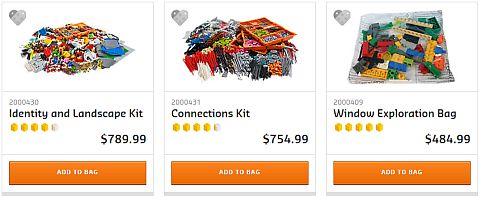
While the #10179 LEGO Star Wars Millennium Falcon continues to occupy the first place as the largest standard retail set, keep in mind that these lists can and probably will change in a few years, as LEGO releases more massive sets. You can find the current selection under the LEGO Exclusives section of the Online LEGO Shop.

So what do you think? Do you agree with my criteria for making the final list? How many of the largest LEGO sets of all time do you have? Fee free to share your thoughts and discuss in the comment section below! 😉
And you may also like to check out the following related posts:












Another thing that would be useful to add is which sets are the largest in volume, instead of just piece count. Lego has been using a lot of tiny parts in some sets, so the piece count may be high, but the set is not that big compared to some others.
Of course this might be harder to judge as some sets are tall, some wide, etc., but still some kind of basic measurement comparison could be interesting.
That’s true. LEGO tends to add a lot of small details to newer sets, which adds to the piece-count, but not necessarily the size. Heck, probably the most accurate method to compare sets would be by weight. 😀
Actually, most of these large sets are pretty similar in size, at least in terms of length/width/height prisms, but actual volume would still be an interesting measurement to make. There are two calculations that could be made: the volume of space the set occupies in a room, or the actual volume of air displaced by the set’s parts. However, because LEGO’s models are quite complex, it would be difficult, if not impossible, to find those. Admin’s suggestion of weight sounds more doable, although I think the UCS Falcon remains on top for that too.
BTW, admin, I like the pictures you added after the lists showing the listed sets; I never thought of that. 🙂
I thought you would like those pictures. That’s why I added them. 🙂
BrickLink does include the weight of the sets, which might help in easy weight comparison, however that also includes the instruction booklets, which can be quite heavy. So yeah, unless someone has all the sets they can measure and weight, it would be pretty difficult to compare. But I guess the project could be crowd-sourced.
Brickset also lists the weight of more recent sets, but I believe that is box weight, i.e. it measures the weight of the box with everything inside, and so includes the packaging as well as parts and instructions. I think the easiest way to find weight would be to dump all the set’s parts into a bowl and weigh it, deducting the bowl’s weight. But yeah, that would be a large project requiring input from many sources.
Also, I was thinking about volume again, and perhaps the simplest volume-related way to rank sets would be to determine their “shelf-space”, or how large a shelf would need to be to fit the set. Pretty much a length-width-height cuboid using LEGO’s product description measurements. Problem is, volume doesn’t tell shape, and most sets have difference shapes. 😕
Yeah, shelf-space would also be a good way to compare sets. I still think though that the Falcon would win no matter which way we compare. 😀
Doesn’t BrickLink have the weights for individual parts and parts lists for sets? Someone sufficiently motivated could write a script to sum the weights for all parts to a set.
Sure, that might work, but I think it would be easier to just ask people who have the set to weight the pieces. After all there are less than 20 super large sets. It should be easier to just ask 20 people than writing a whole program.
Another view is to take price now on say bricklink to do a comparison. Obviously for those available now prices will be retail but trying to get a UCS or a Taj on the secondary market requires very deep pockets indeed. I’m desparate to bricklink a Taj myself but cant work out a way to do it for less than about 600 quid.
Maybe you could look at the instructions and see if there are ways to modify it, such as swapping parts for similar colors, particularly if they aren’t that easily noticed, anyway…
For the UCS absolutely. The problem with the Taj is simply the sheer quantity of parts in white thus a ridiculous amount of bricklink orders. I’m thinking of doing it all gradually over a few years tbh…
That would be a very painful list…
I own the old playable death star! 😀 such an awesome set!
You do? Lucky! 😀
Totally off topic, but what does S.H.I.P. stand for again? It has something to do with a ridiculously large model right? If not what does?
S.H.I.P. = “Seriously Huge Investment in Parts” 😀
I just built one myself 😉 .
It’s a pun on “spaceship”, naturally…
(As many S.H.I.P.’s are Space-S.H.I.P.’s…)
Yes, that too, as spaceship tend to be the largest LEGO creations. 😀
That’s so interesting article ! Thank you for it. Taj Mahal is my favorite! 🙂 Even though I am sure that I will never buy it because of its high price..